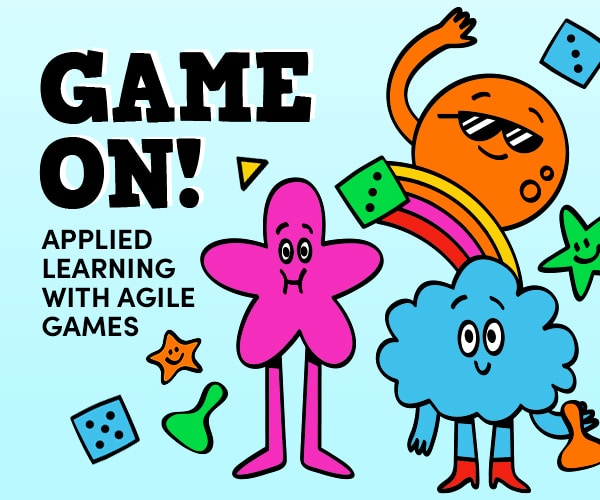Note: The post was first published on Medium here by Sunish Chabba and has been reproduced here as-is.
As an Agile Coach and Consultant, I’ve often grappled with the challenge of maintaining a vibrant, creative atmosphere during workshops and strategy sessions. My love for board games and escape rooms inspired me to design my own escape room game, with a focus on fostering collaboration and communication rather than presenting overly difficult puzzles.
During the COVID-19 pandemic, I even developed a larger-scale game (Project U) that was met with positive feedback. However, the consistent request was for a brief, engaging icebreaker that could cater to both introverted and extroverted team members.
In response to this need, I designed a 10 to 15-minute escape room game for a recent strategic planning workshop with 17 participants. The game was a resounding success, based on the feedback received.
I’m excited to share this game with you here. Please feel free to use it, ask questions, and offer suggestions. It is licensed under Creative Commons (CC BY-NC 4.0). After all, the sharing and exchange of ideas is what helps us all grow and improve.
The Elementalist’s Enigma
“The Elementalist’s Enigma” is an engaging and innovative team-building activity that serves as a perfect icebreaker for any group, whether it be in a corporate setting, a classroom, or a social gathering. This activity uniquely combines the thrill of an escape room game with the collaborative nature of team problem-solving.
One of the key strengths of this game is its ability to be completed in a short amount of time. With a designed completion time of 10–15 minutes, it respects the participants’ time while providing a meaningful and memorable experience. This time efficiency makes it an excellent choice for workshops, meetings, or classes where you want to energize the participants but also have other agenda items to cover.
This game encourages creativity and critical thinking. The puzzles are designed to be challenging but not overwhelming, nudging participants to think outside the box and apply logic and lateral thinking. This can help to stimulate creativity and problem-solving skills, which are valuable in many aspects of work and life.
Furthermore, “The Elementalist’s Enigma” emphasizes communication and collaboration. While participants are divided into three separate teams, they must ultimately work together to solve the final puzzle. This dynamic requires effective communication, fostering a sense of teamwork and cooperation. It highlights the importance of each team member and the value of different perspectives in achieving a common goal.
Additionally, this game provides an opportunity for remote and in-person participants to work together, making it a highly inclusive activity. It’s a testament to how teams can effectively collaborate regardless of physical location, which is particularly relevant in the current era of hybrid working arrangements.
Lastly, the game’s theme and narrative bring an element of fun and adventure. This can help to create a relaxed and enjoyable atmosphere, which is often when people are at their most open and collaborative.
In conclusion, “The Elementalist’s Enigma” is not just a game, but a tool for enhancing teamwork, communication, and creativity within a group. It’s a quick, enjoyable, and effective way to break the ice and foster a collaborative spirit.
Guide to Run “The Elementalist’s Enigma” Escape Room Game
Preparation
1. Prepare the Materials: Ensure all the puzzles, instructions, and necessary materials are ready. This includes the puzzles for each team (Ignis, Aqua, Terra), the final form for submitting answers, and any other materials needed for the game.
2. Set Up the Platform: If you’re using a tool like Miro or another collaborative board, set it up ahead of time. Include the puzzles, instructions, and a space for each team to work. Make sure you have clear sections or boards for each team to avoid confusion.
3. I have written a short program and deployed it on Heroku that takes the input of the last puzzle. Initially, I was thinking of using Google Forms but then found out later that access to file hosting and storage services (including Google Forms)were blocked within the Organisation. With that issue cropping up at the last moment, I had to resolve it ASAP as the workshop was just around the corner. Here is the link to the program and it works, so please feel free to use it. https://tinyurl.com/enigmaescaperoom
4. The riddles are simple and there are hints available in the questions themselves. The challenge is the communication & collaboration aspect. Then, there is a part where one set of information is only available to one group/team (Team Aqua — the order of how to enter). If teams take time to communicate within the game, they will lose the time which will lead to a few key learnings & a few interesting insights on team dynamics as part of the debrief.
Step-by-Step Instructions
1. Introduction: Start by introducing the game to the participants. Explain the premise of the game, the need for collaboration across teams, and the importance of communication.
2. Team Division: Divide the participants into three teams. Consider a mix of roles, skills, and personalities in each team to balance the dynamics. If the participants are from different departments, try mixing them to foster cross-departmental collaboration.
For the remote team, it might be beneficial to group people who are comfortable with or have experience working remotely. This can help streamline their collaboration process.
3. Instructions Distribution:
– For in-person teams, you can hand out printed instructions or display them on a screen. I used the printed instructions (check the Dropbox link provided below) & copied one set to the Miro board for the remote participants working as part of Team Terra.
– For the remote team, you can email the instructions or post them on the Miro board (or similar tool). Make sure the remote team has access to all the necessary resources and they know where to find them.
4. Start the Game: Once the teams have their instructions, start the game. Set a timer for 10 minutes to keep track of time.
5. Monitor Progress: Keep an eye on all teams’ progress. Be available to provide hints or help if needed, but let the teams navigate the puzzles on their own as much as possible.
6. End the Game: When the time is up, or all teams have completed the game, bring everyone back together for the debrief.
Debrief
Once the teams have completed the game, it’s important to facilitate a debrief to reflect on the experience and draw out learning points. Here’s a suggested guide:
- Initial Reactions: Start by asking participants to share their initial reactions and thoughts about the game. This can be as simple as one word or a short phrase to describe their experience.
- Collaboration and Communication: Discuss the importance of collaboration and communication during the game. Ask participants how they felt about the level of communication within and across teams. Did they find it challenging to relay information to other teams? How did they overcome these challenges?
- Team Dynamics: Reflect on the team dynamics that emerged during the game. Did certain individuals take on leadership roles? How were decisions made within the teams? Was everyone’s input considered?
- Remote vs In-person: Reflect on the in-person and remote team dynamic. Did the remote team face any unique challenges? How did the teams bridge the gap?
- Learning Points: Finally, discuss the key learning points from the game. What can participants take away from this experience and apply to their work or other team situations?
Points to Call Out
- The Importance of Collaboration: The game was designed in a way that no team could solve the final puzzle on their own. This underscores the importance of collaboration in achieving common goals.
- Effective Communication: The teams needed to effectively communicate their progress and findings with each other, especially for the final puzzle. This emphasizes the importance of clear and timely communication in team settings.
- Adaptability: The teams had to adapt to the unique dynamics of the game, particularly the mix of in-person and remote participants. This showcases the need for flexibility and adaptability in today’s hybrid work environments.
Remember, the key to a successful debrief is to facilitate a discussion rather than a lecture. Encourage participants to share their thoughts and experiences, and guide the conversation to draw out key learning points.
Tips
- Clear Communication: Make sure all instructions are clear and all participants understand the game mechanics before starting.
- Use of Technology: Leverage technology tools to facilitate collaboration, especially for the remote team. Tools like Miro, Zoom breakout rooms, or Google Docs can be very useful.
- Facilitation: As the facilitator, your role is to guide the process, provide help when needed, and ensure all participants are engaged. Be attentive to the needs of the teams and ready to step in if any conflicts arise.
- Flexibility: Be flexible and ready to adapt. If teams are struggling with a puzzle, be prepared to provide hints or help them move forward.
Remember, the goal of the game is to foster collaboration and team-building. Keep the atmosphere fun and engaging, and ensure all participants feel included and valued. Good luck!
Instructions for each team/group
You can get the handouts and a solution file with tips available in the Dropbox folder here. (Access the Dropbox folder here)
Note that 5–7 people per group (3 teams/groups in total) has worked for me, your mileage may vary.
Introduction to the Activity
Welcome to “The Elementalist’s Enigma” Escape Room Game! This activity is designed as an engaging and interactive icebreaker to foster collaboration and teamwork. You’ll be divided into three teams: Team Ignis (Fire), Team Aqua (Water), and Team Terra (Earth). Each team embarks on a virtual quest to solve their respective riddles and puzzles to unlock the secrets of ancient elemental magic.
This game is designed to be completed within 10 minutes (10 minutes is a good timebox but feel free to extend it to or start with 15), and communication is key. While each team works on their individual puzzles, remember that the final solution can only be reached through collaboration across all teams. Let’s dive into the mystical forest and see what secrets we can uncover together!
Team Ignis (Fire)
1. Puzzle 1: The Flame Riddle
Solve the riddle: “I fly without wings, I cry without eyes. Wherever I go, darkness follows me. What am I?”
2. Puzzle 2: The Fire Dial
A dial with symbols of the sun, moon, star, cloud, and lightning bolt is found. The clue reads: “Turn the dial to the answer of the Flame Riddle.”
3. Puzzle 3: The Ember Cipher
Once the dial is set correctly, an Ember Cipher will be revealed. This is a simple number substitution cipher where A=1, B=2, and so on. The cipher reads: “8–5–1–18–20.” Decode it.
4. Puzzle 4: The Final Revelation
Share your deciphered message with Team Aqua & Team Terra. Then, together, enter your combined message into the form found here.
Team Aqua (Water)
1. Puzzle 1: The Wave Riddle
Solve the riddle: “What comes once in a minute, twice in a moment, but never in a thousand years?”
2. Puzzle 2: The Water Dial
A dial with symbols of A, M, A, Z, and E is found. The clue reads: “Turn the dial to the answer of the Wave Riddle.”
3. Puzzle 3: The Ripple Cipher
Once the dial is set correctly, a Ripple Cipher will be revealed. This is a simple number substitution cipher where Z=1, Y=2, and so on (reverse of Ember Cipher). The cipher reads: “12–13–7–19–22–11–22–26–16.” Decode it.
4. Puzzle 4: The Final Revelation
Share your deciphered message with Team Ignis & Team Terra. Then, together, enter your combined message (format — CAPS, Order — Ignis Aqua Terra) into the form found here.
Team Terra (Earth)
1. Puzzle 1: The Stone Riddle
Solve the riddle: “I speak without a mouth and hear without ears. I have no body, but I come alive with the wind. What am I?”
2. Puzzle 2: The Earth Dial
A dial with symbols of the mountain, valley, forest, desert, and canyon is found. The clue reads: “Turn the dial to the answer of the Stone Riddle.”
3. Puzzle 3: The Quartz Cipher
Once the dial is set correctly, a Quartz Cipher will be revealed. This is a unique cipher where A=Z, B=Y, C=X, and so on (reverse alphabet). The cipher reads: “VEVI”. Decode it.
4. Puzzle 4: The Final Revelation
Share your deciphered message with Teams Ignis and Aqua. Then, together, enter your combined message into the form found here.
Remember, the spirit of this game is collaboration. Though you work as separate teams, your combined effort will lead you to the final solution. Happy solving!






